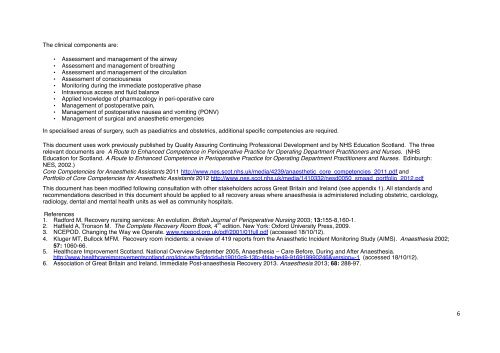Immediate Post-anaesthesia recovery 2013 supplement - aagbi
Immediate Post-anaesthesia recovery 2013 supplement - aagbi
Immediate Post-anaesthesia recovery 2013 supplement - aagbi
Create successful ePaper yourself
Turn your PDF publications into a flip-book with our unique Google optimized e-Paper software.
The clinical components are:• Assessment and management of the airway• Assessment and management of breathing• Assessment and management of the circulation• Assessment of consciousness• Monitoring during the immediate postoperative phase• Intravenous access and fluid balance• Applied knowledge of pharmacology in peri-operative care• Management of postoperative pain,• Management of postoperative nausea and vomiting (PONV)• Management of surgical and anaesthetic emergenciesIn specialised areas of surgery, such as paediatrics and obstetrics, additional specific competencies are required.This document uses work previously published by Quality Assuring Continuing Professional Development and by NHS Education Scotland. The threerelevant documents are A Route to Enhanced Competence in Perioperative Practice for Operating Department Practitioners and Nurses. (NHSEducation for Scotland. A Route to Enhanced Competence in Perioperative Practice for Operating Department Practitioners and Nurses. Edinburgh:NES, 2002.)Core Competencies for Anaesthetic Assistants 2011 http://www.nes.scot.nhs.uk/media/4239/anaesthetic_core_competencies_2011.pdf andPortfolio of Core Competencies for Anaesthetic Assistants 2012 http://www.nes.scot.nhs.uk/media/1410332/nesd0050_smaad_portfolio_2012.pdfThis document has been modified following consultation with other stakeholders across Great Britain and Ireland (see appendix 1). All standards andrecommendations described in this document should be applied to all <strong>recovery</strong> areas where <strong>anaesthesia</strong> is administered including obstetric, cardiology,radiology, dental and mental health units as well as community hospitals.References1. Radford M. Recovery nursing services: An evolution. British Journal of Perioperative Nursing 2003; 13:155-8,160-1.2. Hatfield A, Tronson M. The Complete Recovery Room Book, 4 th edition. New York: Oxford University Press, 2009.3. NCEPOD. Changing the Way we Operate. www.ncepod.org.uk/pdf/2001/01full.pdf (accessed 18/10/12).4. Kluger MT, Bullock MFM. Recovery room incidents: a review of 419 reports from the Anaesthetic Incident Monitoring Study (AIMS). Anaesthesia 2002;57: 1060-66.5. Healthcare Improvement Scotland. National Overview September 2005, Anaesthesia – Care Before, During and After Anaesthesia.http://www.healthcareimprovementscotland.org/idoc.ashx?docid=b19010c9-13fc-4f4a-be49-916919990246&version=-1 (accessed 18/10/12).6. Association of Great Britain and Ireland. <strong>Immediate</strong> <strong>Post</strong>-<strong>anaesthesia</strong> Recovery <strong>2013</strong>. Anaesthesia <strong>2013</strong>; 68: 288-97.6
















